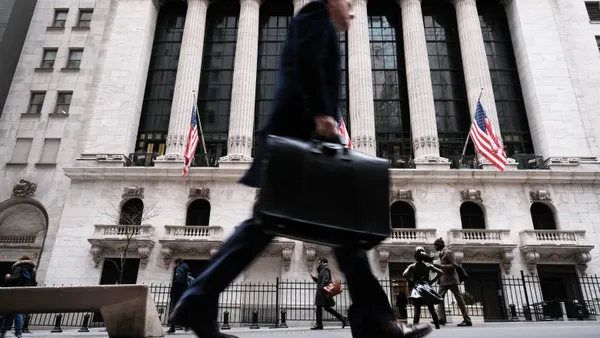Dive Brief:
- The New York State Common Retirement Fund announced Monday it has committed around $2.4 billion to three funds focused on climate and sustainable solutions.
- The pension plan made the investment through its Sustainable Investments and Climate Solutions Program, pledging $2 billion to the FTSE Russell TPI 1000 Climate Transition Index, $250 million to the Oaktree Power Opportunities Fund VII and $150 million to the Vision Ridge Partners Sustainable Asset Fund IV, according to the release.
- The investment builds on the state pension plan’s broader goal of committing $40 billion toward sustainable funds and efforts to address climate risk by 2035. State Comptroller Thomas DiNapoli, who oversees the pension plan, set the target last year after the fund met an initial goal of $20 billion in sustainable investments.
Dive Insight:
The New York State Common Retirement Fund is the third largest state pension fund in the U.S., with approximately $273.4 billion in assets, and has deployed over $26.5 billion to climate and sustainability-focused investments thus far, per the release. This financing has been offered across various asset classes including public equity, private equity, fixed income and credit financing, according to the fund.
The three funds that the pension plan invested in this week all focus on either the climate transition or supporting green infrastructure.
The FTSE Russell TPI 1000 Climate Transition Index weighs global companies based on their carbon emissions, exposure to fossil fuels and green revenues, and the Oaktree Power Opportunities Fund VII targets investments that boost renewable energy and infrastructure projects like solar and water systems in North America. Vision Ridge Partners’ sustainable asset fund focuses on climate mitigation and adaptation efforts across the energy, transportation and agriculture sectors in North America.
The New York pension plan says on its website that it incorporates ESG factors within its investment framework “because they can influence both risks and returns.” The fund’s investment philosophy also states it will “keep focusing on long-term climate resilience in line with fiduciary duty.”
In 2020, DiNapoli announced that the retirement fund had set a goal of net-zero portfolio emissions by 2040, which built off a Climate Action Plan introduced in 2019. The climate action plan sets minimum standards for the fund to determine if a company is prepared for a low carbon-transition.
Last year, the fund said it was divesting holdings worth approximately $26.8 billion from eight oil and gas companies after reviewing their strategies to shift to a low-carbon economy. These companies included ExxonMobil — which represented the bulk of the divestment — Guanghui Energy Company, Echo Energy, IOG, Oil and Natural Gas Corp., Delek Group, Dana Gas and Unit Corp.
The state comptroller said in his April 21 update that the fund has also completed its annual review of fossil fuel companies, as part of its broader evaluation of companies that face significant climate risk and their readiness to incorporate a low-carbon transition.
DiNapoli said the fund will continue to restrict investments in 39 coal, gas, oil sands and shale oil companies and has newly added eight companies to this list. These include Kinetic Development Group, NLC India, PT Petrindo Jaya Kreasi Tbk, Yancoal Australia, Civitas Resources, Peyto Exploration & Development, Texas Pacific Land Corp. and Viper Energy Inc.
“Climate change poses a real threat to our investments, but the actions announced today will help position the Fund to address those risks and seize on opportunities generated as the world transitions to a low-carbon economy,” DiNapoli said. “The fund is a leader on addressing the investment challenges posed by climate change and our efforts continue.”












